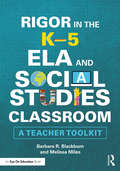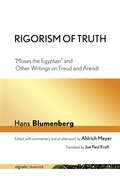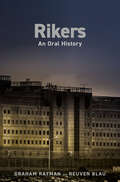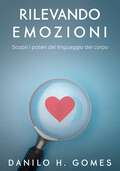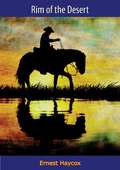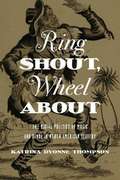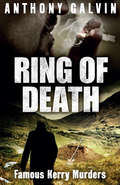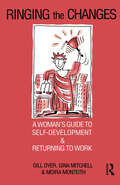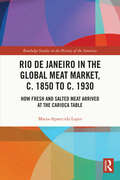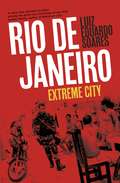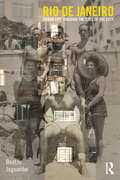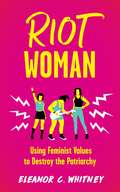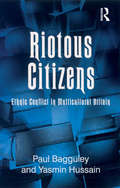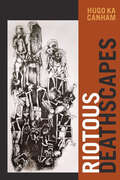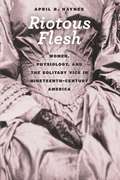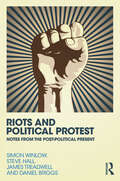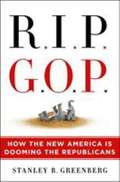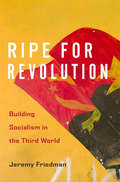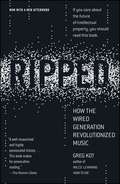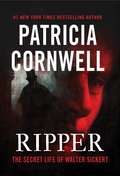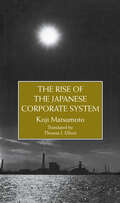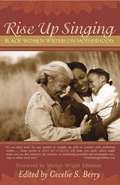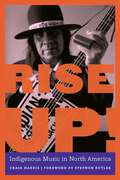- Table View
- List View
Rigor in the K–5 ELA and Social Studies Classroom: A Teacher Toolkit
by Barbara R. Blackburn Melissa MilesLearn how to incorporate rigorous activities into your English language arts or social studies classroom and help students reach higher levels of learning. Expert educators and consultants Barbara R. Blackburn and Melissa Miles offer a practical framework for understanding rigor and provide specialized examples for elementary ELA and social studies teachers. Topics covered include: Creating a rigorous environment High expectations Support and scaffolding Demonstration of learning Assessing student progress Collaborating with colleagues The book comes with classroom-ready tools, offered in the book and as free eResources on our website at www.routledge.com/9781138598959.
Rigorism of Truth: "Moses the Egyptian" and Other Writings on Freud and Arendt (signale|TRANSFER: German Thought in Translation)
by Hans BlumenbergIn "Moses the Egyptian"—the centerpiece of Rigorism of Truth, the German philosopher Hans Blumenberg addresses two defining figures in the intellectual history of the twentieth century: Sigmund Freud and Hannah Arendt. Unpublished during his lifetime, this essay analyzes Freud’s Moses and Monotheism (1939) and Arendt’s Eichmann in Jerusalem (1963), and discovers in both a principled rigidity that turns into recklessness because it is blind to the politics of the unknown.Offering striking insights into the importance of myth in politics and the extent to which truth can be tolerated in adversity, the essay also provides one of the few instances where Blumenberg reveals his thinking about Judaism and Zionism. Rigorism of Truth also includes commentaries by Ahlrich Meyer that give a fuller understanding of the philosopher’s engagement with Freud, Arendt, and the Eichmann trial, as well as situating these reflections in the broader context of Blumenberg’s life and thought.
Rikers: An Oral History
by Graham Rayman Reuven BlauA shocking, groundbreaking oral history of the infamous Rikers jail complex and an unflinching portrait of injustice and resilience told by the people whose lives have been forever altered by it &“This mesmerizing and gut-wrenching book shows the brutal realities that tens of thousands of people have been forced to navigate, and survive, in America&’s most notorious jail.&”—Piper Kerman, New York Times bestselling author of Orange is the New BlackWhat happens when you pack almost a dozen jails, bulging at the seams with society&’s cast-offs, onto a spit of landfill purposefully hidden from public view? Prize-winning journalists Graham Rayman and Reuven Blau have spent two years interviewing more than 130 people comprising a broad cross section of lives touched by New York City's Rikers Island prison complex—from incarcerated people and their relatives, to officers, lawyers, and commissioners, with stories spanning the 1970s to the present day. The portrait that emerges calls into question the very nature of justice in America. Offering a 360-degree view inside the country&’s largest detention complex, the deeply personal accounts—featured here for the first time—take readers on a harrowing journey into every corner of Rikers, a failed society unto itself that reflects society&’s failings as a whole. Dr. Homer Venters was shocked by the screams on his first day working at Rikers: &“They&’re in solitary, just yelling . . . the yelling literally never stops.&” After a few months, though, Dr. Venters notes, one's ears adjust to the sounds. Nestor Eversley recalls how detainees made weapons from bones. Barry Campbell recalls hiding a razor blade in his mouth—&“just in case&”. These are visceral stories of despair, brutality, resilience, humor, and hope, told by the people who were marooned on the island over the course of decades. As calls to shutter jails and reduce the number of incarcerated people grow louder across the country, with the movement to close the island complex itself at the forefront, Rikers is a resounding lesson about the human consequences of the incarceration industry.
Rilevando emozioni: Scopri i poteri del linguaggio del corpo
by Danilo H. GomesPoche persone possono leggere facilmente i gesti umani. Questo è un compito che richiede osservazione e concentrazione. Tuttavia, l'interpretazione del linguaggio del corpo è possibile per coloro che hanno le conoscenze necessarie. RILEVANDO EMOZIONI contiene l'ideale per chi vuole apprendere, in modo rapido e diretto, i significati nascosti dietro ogni movimento umano. Conoscere più profondamente il linguaggio del corpo: parti del corpo, possemica, segni della menzogna/verità e prime impressioni. Imparate a leggere i gesti umani con facilità, conoscendo i punti fondamentali del linguaggio del corpo.
Rim of the Desert
by Ernest HaycoxTHE LAW OF LEAD IN THE WESTThe Broken Bit boys shot Sheriff Ben Borders after the nesters and law-abiders had re-elected him. Old Ben lay dying on the courthouse steps with Jim Keene looking down at him.“You stayin’?” said Ben.“I’ll be staying,” said Jim.“Well, when you get to the other side of the hill—remember this, son—the only thing you’ll find there is just what you brought with you.”Jim Keene had ridden a thousand miles to get to Cloud Valley and away from trouble. He was a strong man and a fighting man, but he always took sides. He couldn’t help fighting for the underdog. And when he got to Cloud Valley he found that he couldn’t run away from himself.With the sheriff dead, there was no law. So Jim Keene dealt himself in on the fight—on the side of the weak—and shot his way to justice…
Ring Shout, Wheel About: The Racial Politics of Music and Dance in North American Slavery
by Katrina Dyonne ThompsonIn this ambitious project, historian Katrina Thompson examines the conceptualization and staging of race through the performance, sometimes coerced, of black dance from the slave ship to the minstrel stage. Drawing on a rich variety of sources, Thompson explicates how black musical performance was used by white Europeans and Americans to justify enslavement, perpetuate the existing racial hierarchy, and mask the brutality of the domestic slave trade. Whether on slave ships, at the auction block, or on plantations, whites often used coerced performances to oppress and demean the enslaved. As Thompson shows, however, blacks' "backstage" use of musical performance often served quite a different purpose. Through creolization and other means, enslaved people preserved some native musical and dance traditions and invented or adopted new traditions that built community and even aided rebellion. Thompson shows how these traditions evolved into nineteenth-century minstrelsy and, ultimately, raises the question of whether today's mass media performances and depictions of African Americans are so very far removed from their troublesome roots.
Ring of Death: Famous Kerry Murders
by Anthony GalvinTo all appearances, Kerry is an idyllic tourist destination. Yet scratch beneath its scenic surface and the sordid secrets of the county known as 'the Kingdom’ flow free like blood . . .Some of the most notorious murders in the history of Ireland have taken place in Kerry, including a two-day orgy of slaughter perpetrated by state forces during the Civil War. Another is the case of two farmers fighting over a patch of land not big enough to accommodate a picnic blanket, resulting in a killing that inspired the play and film The Field. The county’s most infamous case was the discovery of a baby stabbed to death on a beach, with another infant’s body found during the subsequent investigation. To this day, the identities of the children, their mothers and the murderer remain a mystery, but the case led to the government setting up a tribunal to investigate the Gardaí and how they had handled the inquiry.In Ring of Death, true-crime writer Anthony Galvin explores the bloody history of Kerry and the many fascinating murder cases that have occurred in the county over the past century.
Ringing The Changes
by Gill Dyer Moira Monteith Gina MitchellFirst published in 1991. Ringing the Changes is a realistic and practical guide that provides ideas, information and advice for women planning a return to work or study after a career break. Gill Dyer, Gina Mitchell and Moira Monteith draw widely upon their own experiences both as tutors and as women juggling with the conflicting demands of personal and work commitments. This hlepful book includes case studies illustrating the problems faced by women returners and exercises designed to develop communication skills and build self confidence. The text is accompanied by Angela Martin's humorous and delightful illustrations. This book should be of interest to women considering a return to work and to teachers in adult education.
Rio de Janeiro in the Global Meat Market, c. 1850 to c. 1930: How Fresh and Salted Meat Arrived at the Carioca Table
by Maria-Aparecida LopesThis book examines the meat provision system of Rio de Janeiro from the 1850s to the 1930s. Until the 1920s, Rio was Brazil’s economic hub, main industrial city, and prime consumer market. Meat consumption was an indicator of living standards and a matter of public concern. The work unveils that in the second half of the nineteenth century, the city was well supplied with red meat. Initially, dwellers relied mostly on salted meat; then, in the latter decades of the 1800s, two sets of changes upgraded fresh meat deliveries. First, ranching expansion and transportation innovation in southeast and central-west Brazil guaranteed a continuous flow of cattle to Rio. Second, the municipal centralization of meat processing and distribution made its provision regular and predictable. By the early twentieth century, fresh meat replaced salted meat in the urban marketplace. This study examines these developments in light of national and global developments in the livestock and meat industries.
Rio de Janeiro: Extreme City
by Luiz Eduardo SoaresA book as rich and sprawling as the seductive metropolis it evokes, Rio de Janeiro builds a kaleidoscopic portrait of this city of extremes, and its history of conflict and corruption. Award-winning novelist, ex-government minister and sociologist, Luiz Eduardo Soares tells the story of Rio through the everyday lives of its people: gangsters and police, activists, politicians and struggling migrant workers, each with their own version of the city. Taking us on a journey into Rio's intricate world of favelas, beaches and corridors of power, Soares reveals one of the most extraordinary cities in the world in all its seething, agonistic beauty.
Rio de Janeiro: Urban Life through the Eyes of the City (CRESC)
by Beatriz Jaguaribe"Through artistic imaginaries, media productions, social practices and spatial mappings, this book offers an insightful and original contribution to the understanding of Rio de Janeiro, one of the highly contested urban terrains in the world. Offering a rich diversity of examples extracted from lived experience, iconographic materials, and narratives, it provides innovative and compelling connections between theoretical questions and urban vignettes. Throughout the essays, the specificity of Rio de Janeiro is highlighted but framed in relation to theoretical questions that are relevant to major contemporary cities. The book underlines the dilemmas of a city that attempts to compete globally while confronting social inequality, violence, and novel forms of democratic agency. It retraces Rio de Janeiro’s modernist memories as the former political/cultural capital of Brazilian intelligentsia and national culture. It explores Rio as a city of popular culture, mestizo legacies, media productions, and cultural innovation."
Riot Woman: Using Feminist Values to Destroy the Patriarchy
by Eleanor C. WhitneyGrowing up immersed in the feminist, DIY values of punk, Riot Grrrl, and zine culture of the 1990s and early 2000s gave Eleanor Whitney, like so many other young people who gravitate towards activism and musical subcultures, a sense of power, confidence, community, and social responsibility. As she grew into adulthood she struggled to stay true to those values, and with the gaps left by her punk rock education. This insightful, deeply personal history of early-2000s subcultures lovingly explores the difficulty of applying feminist values to real-life dilemmas, and embrace an evolving political and personal consciousness. Whitney traces the sometimes painful clash between her feminist values and everyday, adult realities — and anyone who has worked to integrate their political ideals into their daily life will resonate with the histories and analysis on these pages, such as engaging in anti-domestic violence advocacy while feeling trapped in an unhealthy relationship, envisioning a unified "girl utopia" while lacking racial consciousness, or espousing body positivity while feeling ambivalent towards one's own body. Throughout the book, the words and power of Bikini Kill and other Riot Grrrl bands ground the story and analysis, bringing it back to the raw emotions and experiences that gave this movement its lasting power while offering a complex, contemporary look at the promises and pitfalls of Riot Grrrl-informed feminism.
Rioting in the UK and France
by David Waddington Mike King Fabien JobardThe broad aim of this book is to provide a general basis for comparatively analysing and understanding the French riots of October/November 2005 and the corresponding Bristish disorders which occurred in the spring/summer of 2001. The first of the French riots broke out on 27 October in the north Parisian banlieue (suburb) of Clichy-sous-Bois when two teenage youths of Muslim heritage were electrocuted in a substation while fleeing from the police. The two youths had apparently become unwittingly involved, together with their friends, in a police investigation of a break-in. It is not clear whether they had actually been chased by police officers. Nevertheless, a rumor to this effect quickly circulated the locality, provoking violent confrontation between youths and police. Three more weeks of rioting then ensued in neighbouring Parisian suburbs and other major French cities with similar concentrations of ethnic minorities. The riots invariably involved thousands of youths from poorer areas who confronted the police, set fire to local buildings and ignited hundreds of motor vehicles. Further rioting - though not on the same scale as in 2005 - occurred subsequently in 2006 and 2007. England and Wales have had their own counterparts to the French riots. In the early and mid 1980s, there were a number of clashes between police and African-Caribbean youths in inner-city areas. Further, in 2001 rioting broke out in the northern mill towns and cities of Bradford, Burnley, Leeds and Oldham. All of these later instances involved youths from Pakistani or Bangladeshi descent. In contrast to the riots that occurred in France though, a contributing factor to 2001 riots was the activities of white neo-Fascists. Many official reports and academic studies followed each wave of disorder, each questioning the effectiveness of Britain's 'multicultural' society, in addition to other possible factors such as the marginalisation and 'criminalisation' of minority ethnic youth, and their relations with the police. Such issues were again on the agenda after more rioting occurred in the Lozells area of Birmingham in 2005. Unlike the previous disorders, this entailed conflict between South Asian and African-Caribbean youths, following a rumor that a young African girl had been gang-raped by South Asians. British attempts to analyse and remedy the underlying causes of the riots constitute a potentially valuable resource to French academics, practitioners and policy makers. In turn, the French experience provides a fertile basis for re-applying, testing and enhancing existing British theory and policy. The book consists of a highly coherent, theoretically rich and thematically comprehensive collection of papers which provide an unparalleled description and comparative analysis of the French and British riots, along with social policy recommendations to help to address the underlying issues.
Riotous Citizens: Ethnic Conflict in Multicultural Britain
by Paul Bagguley Yasmin HussainIn 2001, Britain saw another summer of rioting in its cities, with violent uprisings in Oldham, Burnley and Bradford. This book explores the reasons for those riots and explains why they mark a new departure in Britain's racial politics. Riots involving racial factors are nothing new in Britain. Historically violent uprisings could be blamed on heavy policing of predominantly minority communities, but the riots of 2001 were more complex. With elements of 1950s-style race riots and echoes of the 1980s riots which saw South Asians confronting the police as the adversary, the spread of unrest in 2001 was also clearly linked to poverty, unemployment and the involvement of the political far-right. Linking original empirical research conducted amongst the Pakistani community in Bradford with a sophisticated conceptual analysis, this book will be required reading for courses on race and ethnicity, social movements and policing public order.
Riotous Deathscapes
by Hugo ka CanhamIn Riotous Deathscapes, Hugo ka Canham presents an understanding of life and death based on indigenous and black ways of knowing that he terms Mpondo theory. Focusing on amaMpondo people from rural Mpondoland, in South Africa’s Eastern Cape, Canham outlines the methodologies that have enabled the community’s resilience and survival. He assembles historical events and a cast of ancestral and living characters, following the tenor of village life, to offer a portrait of how Mpondo people live and die in the face of centuries of abandonment, trauma, antiblackness, and death. Canham shows that Mpondo theory is grounded in and develops in relation to the natural world, where the river and hill are key sites of being and resistance. Central too, is the interface between ancestors and the living, in which life and death become a continuity and a boundlessness that white supremacy and neoliberalism cannot interdict. By charting a course of black life in Mpondoland, Canham tells a story of blackness on the African continent and beyond.Duke University Press Scholars of Color First Book Award Recipient
Riotous Flesh: Women, Physiology, and the Solitary Vice in Nineteenth-Century America
by April R. HaynesNineteenth-century America saw numerous campaigns against masturbation, which was said to cause illness, insanity, and even death. Riotous Flesh explores women's leadership of those movements, with a specific focus on their rhetorical, social, and political effects, showing how a desire to transform the politics of sex created unexpected alliances between groups that otherwise had very different goals. As April R. Haynes shows, the crusade against female masturbation was rooted in a generally shared agreement on some major points: that girls and women were as susceptible to masturbation as boys and men; that "self-abuse" was rooted in a lack of sexual information; and that sex education could empower women and girls to master their own bodies. Yet the groups who made this education their goal ranged widely, from "ultra" utopians and nascent feminists to black abolitionists. Riotous Flesh explains how and why diverse women came together to popularize, then institutionalize, the condemnation of masturbation, well before the advent of sexology or the professionalization of medicine.
Riots And Victims: Violence And The Construction Of Communal Identity Among Bengali Muslims, 1905-1947
by Patricia A. Gossman Patricia A. GrossmanIn recent decades, the world has witnessed the emergence of several protracted violent conflicts and the eruption of ethnic and communal violence in countries such as Bosnia, Rwanda, and Sri Lanka. Riots and Victims challenges the popular academic interpretation of such events as examples of tribal slaughter or spontaneous eruptions, fueled by historic conflict between religious and ethnic communities. This book examines the origins and consequences of the violence that occurred between the Muslim and Hindu communities in pre-partition Bengal, which ultimately resulted in the creation of Pakistan. Gossman argues that communal violence and communal identity were not merely the consequences of long-term animosities, but rather ploys orchestrated by mid-level politicians for their own advancement and aggrandizement. Riots and Victims introduces new analyses of local violence and identity, and explores issues of far-reaching importance.
Riots and Political Protest
by James Treadwell Steve Hall Simon Winlow Daniel BriggsThe years 2008 to 2013 saw a new generation of political protestors take to the streets. Riots disrupted many Western cities and new protest movements emerged, keen to address a bleak context of economic collapse and austerity politics. In this groundbreaking new study, Winlow, Hall, Briggs and Treadwell push past the unworldly optimism of the liberal left to offer an illuminating account of the enclosure and vacuity of contemporary politics. Focusing on the English riots of 2011, the ongoing crisis in Greece, the Indignados, 15M and Podemos in Spain, the Occupy movement in New York and London and the English Defence League in northern England, this book uses original empirical data to inform a strident theoretical critique of our post-political present. It asks: what are these protest groups fighting for, and what are the chances of success? Written by leading criminological theorists and researchers, this book makes a major contribution to contemporary debates on social order, politics and cultural capitalism. It illuminates the epochal problems we face today. Riots and Political Protest is essential reading for academics and students engaged in the study of political sociology, criminological theory, political theory, sociological theory and the sociology of deviance.
Rip GOP: How the New America Is Dooming the Republicans
by Stanley GreenbergFor decades the GOP has seen itself in an uncompromising struggle against a New America that is increasingly secular, racially diverse, and fueled by immigration. It has fought non-traditional family structures, ripped huge holes in the social safety net, tried to stop women from being independent, and pitted aging rural Evangelicals against the younger, more dynamic cities. <P><P>Since the 2010 election put the Tea Party in control of the GOP, the party has condemned America to years of fury, polarization, and broken government. The election of Donald Trump enabled the Republicans to make things even worse. All seemed lost. <P><P>But the Republicans have set themselves up for a shattering defeat. <P><P>In RIP GOP, Stanley Greenberg argues that the 2016 election hurried the party's imminent demise. Using amazing insights from his focus groups with real people and surprising revelations from his own polls, Greenberg shows why the GOP is losing its defining battle. He explores why the 2018 election, when the New America fought back, was no fluke. And he predicts that in 2020, the party of Lincoln will be left to the survivors, opening America up to a new era of renewal and progress.
Ripe for Revolution: Building Socialism in the Third World
by Jeremy FriedmanA historical account of ideology in the Global South as the postwar laboratory of socialism, its legacy following the Cold War, and the continuing influence of socialist ideas worldwide. In the first decades after World War II, many newly independent Asian and African countries and established Latin American states pursued a socialist development model. Jeremy Friedman traces the socialist experiment over forty years through the experience of five countries: Indonesia, Chile, Tanzania, Angola, and Iran. These states sought paths to socialism without formal adherence to the Soviet bloc or the programs that Soviets, East Germans, Cubans, Chinese, and other outsiders tried to promote. Instead, they attempted to forge new models of socialist development through their own trial and error, together with the help of existing socialist countries, demonstrating the flexibility and adaptability of socialism. All five countries would become Cold War battlegrounds and regional models, as new policies in one shaped evolving conceptions of development in another. Lessons from the collapse of democracy in Indonesia were later applied in Chile, just as the challenge of political Islam in Indonesia informed the policies of the left in Iran. Efforts to build agrarian economies in West Africa influenced Tanzania’s approach to socialism, which in turn influenced the trajectory of the Angolan model. Ripe for Revolution shows socialism as more adaptable and pragmatic than often supposed. When we view it through the prism of a Stalinist orthodoxy, we miss its real effects and legacies, both good and bad. To understand how socialism succeeds and fails, and to grasp its evolution and potential horizons, we must do more than read manifestos. We must attend to history.
Ripped: How the Wired Generation Revolutionized Music
by Greg KotA decade ago the vast majority of mainstream music was funneled through a handful of media conglomerates. Now, more people are listening to more music from a greater variety of sources than at any time in history. And big corporations such as Viacom, Clear Channel, and Sony are no longer the sole gatekeepers and distributors, their monopoly busted by a revolution -- an uprising led by bands and fans networking on the Internet. Ripped tells the story of how the laptop generation created a new grassroots music industry, with the fans and bands rather than the corporations in charge. In this new world, bands aren't just musicmakers but self-contained multimedia businesses; and fans aren't just consumers but distributors and even collaborators. As the Web popularized bands and albums that previously would have been relegated to obscurity, innovative artists -- from Prince to Death Cab for Cutie -- started coming up with, and stumbling into, alternative ways of getting their music out to fans. Live music took on an even more significant role. TV shows and commercials emerged as great places to hear new tunes. Sample-based composition and mash-ups leapfrogged ahead of the industry's, and the law's, ability to keep up with them. Then, in 2007, Radiohead released an album exclusively on the Internet and allowed customers to name their own price, including $0.00. Radiohead's "it's up to you" marketing coup seized on a concept the old music industry had forgotten: the customer is always right. National radio host and critically acclaimed music journalist Greg Kot masterfully chronicles this story of how we went from $17.99 to $0.00 in less than a decade. It's a fascinating tale of backward thinking, forward thinking, and the power of music.
Ripper: The Secret Life Of Walter Sickert
by Patricia CornwellFrom New York Times bestselling author Patricia Cornwell comes Ripper: The Secret Life of Walter Sickert, a comprehensive and intriguing expos of one of the world's most chilling cases of serial murder--and the police force that failed to solve it. <P><P>Vain and charismatic Walter Sickert made a name for himself as a painter in Victorian London. But the ghoulish nature of his art--as well as extensive evidence--points to another name, one that's left its bloody mark on the pages of history: Jack the Ripper. Cornwell has collected never-before-seen archival material--including a rare mortuary photo, personal correspondence and a will with a mysterious autopsy clause--and applied cutting-edge forensic science to open an old crime to new scrutiny. <P><P>Incorporating material from Portrait of a Killer: Jack the Ripper--Case Closed, this new edition has been revised and expanded to include eight new chapters.
Rise Of The Japanese Corporate S: The Inside View Of A Miti Official (Japanese Studies)
by MatsumotoFirst published in 1991. Routledge is an imprint of Taylor & Francis, an informa company.
Rise Up Singing
by Cecelie BerryFrom a dazzling array of well-known African American women, short fiction, poems, and personal essays that describe with warmth and humor their experiences as mothers and as daughters. A sparkling anthology devoted to exploring the lives of African American mothers, Rise Up Singing presents the stories and reflections of such beloved and respected artists, journalists, and authors as Alice Walker, Faith Ringgold, Marita Golden, Martha Southgate, Tananarive Due, Maya Angelou, Gwendolyn Brooks, Deborah Roberts, Rita Dove, and others. It features original and previously published writings, organized by editor Cecelie Berry by themes--mothering, work, family, children, community, and love--that illuminate the multiple roles of black mothers at home, in the neighborhood, and in the world as a whole. Rise Up Singing brings together the perspectives of women of different ages, backgrounds, and accomplishments. What shines through in their writings are the hopes shared by all mothers. As Marian Wright Edelman writes in the Foreword: "The mothers writing in this anthology speak in a range of voices. They are joyful, stressed, grateful, ambivalent, determined, disappointed, and, in bad ways and good, overwhelmed. But over and over again ... we see mothers struggling with the push: striving to give their children their best and to make sure the world gives their children its best, hard as that fight may be."
Rise Up!: Indigenous Music in North America
by Craig HarrisMusic historian Craig Harris explores more than five hundred years of Indigenous history, religion, and cultural evolution in Rise Up! Indigenous Music in North America. More than powwow drums and wooden flutes, Indigenous music intersects with rock, blues, jazz, folk music, reggae, hip-hop, classical music, and more. Combining deep research with personal stories by nearly four dozen award-winning Indigenous musicians, Harris offers an eye-opening look at the growth of Indigenous music. Among a host of North America&’s most vital Indigenous musicians, the biographical narratives include new and well-established figures such as Mildred Bailey, Louis W. Ballard, Cody Blackbird, Donna Coane (Spirit of Thunderheart), Theresa &“Bear&” Fox, Robbie Robertson, Buffy Sainte-Marie, Joanne Shenandoah, DJ Shub (Dan General), Maria Tallchief, John Trudell, and Fawn Wood.
